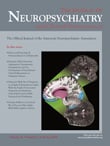Clozapine-Induced Tardive Dyskinesia and Hypothyroidism
SIR: With the advent of atypical antipsychotics, the prevalence and incidence of tardive dyskinesia are on the decline. However, the literature is spotted with anecdotal reports of tardive dyskinesia associated with atypical antipsychotics. Clozapine, the only atypical antipsychotic shown to be effective for tardive dyskinesia in controlled studies, has been shown to cause tardive dyskinesia on rare occasions. 1 The authors report a similar case and also discuss the putative interaction of hypothyroidism and the dopaminergic system in the expression of tardive dyskinesia.
Case Report
Mrs. A, a 47-year-old woman, was diagnosed with schizophrenia of 6 years’ duration. Her symptoms were characterized by hallucinatory behavior, delusions of persecution, decreased personal care and withdrawn behavior. A year after the onset of illness, she was also found to have hypothyroidism as her thyroid stimulating hormone level was raised (29 mU/liter; normal range=0.4–6 mU/liter). At that time she was started on levothyroxine 50 mcg daily (increased to 100 mcg daily) and trifluoperazine 15 mg. daily. This combination was continued for a year, and subsequently trifluoperazine was replaced by risperidone 9 mg daily without a favorable result. Hence, risperidone was stopped after continuing it for about 10 months. She also had a brief trial of haloperidol but had poor drug adherence due to extrapyramidal side effects. Subsequently, the patient was started on clozapine, titrated to 150 mg daily while the levothyroxine was continued at 100 mcg. daily. She showed a marked improvement in positive as well as negative symptoms, and her thyroid profile continued to remain normal. Seven months after starting clozapine, she exhibited horizontal grinding movements of the lower jaw and dyskinetic movements of the tongue. These movements would subside temporarily on bringing these to patient’s attention. She scored 9 on Abnormal Involuntary Movement Scale (AIMS). Speculating that levothyroxine may be contributing to the movement disorder, it was stopped for 8 weeks without any effect on the movements or the AIMS score, but her thyroid stimulating hormone level increased again (16 mU/liter). Levothyroxine was again added to clozapine, and within 6 weeks her thyroid profile returned to normal. Her neurological examination, other than that for the dyskinetic movements, was unremarkable and so was a head computed tomography scan and an electroencephalogram. A sequential trial of propranolol 80 mg daily and tetrabenazine 125 mg daily did not ameliorate the dyskinesia. The patient was subsequently deemed to have developed tardive dyskinesia and met DSM-IV criteria for this condition. An attempt was made to reduce the dose of clozapine from 150 mg daily to 125 mg daily but was limited by worsening of psychotic symptoms resulting in the patient ending up on a higher dose than before (200 mg daily). Neither reduction nor increase in the dose of clozapine showed any improvement in the dyskinetic movements, and the patient continues to exhibit these movements.
Comment
To our knowledge, there have been no reports associating clozapine-induced tardive dyskinesia and hypothyroidism. Although it can be argued that this patient may have developed withdrawal dyskinesia on discontinuing typical antipsychotics or risperidone, the temporal correlation between the introduction of clozapine and appearance of tardive dyskinesia favors clozapine as the likely etiology in this patient. It would be interesting to explore if the effect of thyroid hormones on the dopaminergic system may contribute toward appearance of tardive dyskinesia in patients on antipsychotics. Hypothyroidism has been associated with subsensitivity of striatal dopamine receptors, 2 and thyroid hormones potentiate dopaminergic behavior. 3 A study carried out in rats treated with haloperidol revealed significant upregulation of dopamine receptors in hypothyroid rats compared to hyperthyroid rats. 4 Furthermore, there is a report of tardive dyskinesia associated with sulpiride, a dopamine receptor antagonist, in a patient with hypothyroidism. 5 Interestingly, a report also indicates exacerbation of orofacial dyskinesias with nomifensine, a dopaminergic antidepressant, in an elderly woman with hypothyroidism. 6 Thus, future research into the complex interplay of the dopaminergic system and thyroid dysfunction in the expression of tardive dyskinesia is encouraged.
1. de Leon J, Moral L, Camunas C: Clozapine and jaw dyskinesia: a case report. J Clin Psychiatry 1991; 52:494–495Google Scholar
2. Goetz CG, Weiner WJ, Klawans HL: Treatment of chorea, in Disorders of Movement. Edited by Barbeau A. Lancaster, England, MTP Press, 1989, pp 29–43Google Scholar
3. Klawans HL, Goetz CG, Weiner WJ: Dopamine receptor site sensitivity in hyperthyroid guinea pigs: a possible model of hyperthyroid chorea. J Neural Transm 1973; 34:187–193Google Scholar
4. Crocker AD, Overstreet DH: Modification of the behavioral effects of haloperidol and of dopamine receptor regulation by altered thyroid status. Psychopharmacol 1984; 82:102–106Google Scholar
5. Sandyk R: Tardive dyskinesia induced by sulpiride in a patient with hypothyroidism. Clin Neuropharmacol 1986; 9:100–101Google Scholar
6. Sandyk R, Gilman MA: Nomifensine exacerbates orofacial dyskinesia in hypothyroidism. Neurology 1985; 35:282Google Scholar



